This is a guest post written in collaboration with Joe Dinoffer, the founder & President of OnCourt OffCourt, a company in Dallas, TX selling equipment and training aids for tennis. More about Joe at the bottom of this page.
When you buy a product through our links below, we may earn money from our affiliate partners to help support the site. However, this does not affect our evaluation or recommendation of each product. See our list of partners & how we get paid here. You can also learn our process for reviewing tennis gear here.
If you want to get better at tennis, you need to work on specific skills. Tennis training aids help you improve those skills faster. Tennis coaches and players all over the world use training aids to get better every day. Below we are going to show what they are, why they’re important, and review the 14 best tennis training aids on the market. No matter what area of tennis you want to improve, below you’ll find a training aid for you.
Before reading the reviews, you can see our list of the top 14 tennis training aids here.
- Topspin Pro: #1 Way to Learn Topspin
- Functional Tennis Saber: Best Way to Hit a Clean Ball
- The Flex Trainer: Move Better on the Court
- Sweet Spot Trainer: Make Better Contact
- Start Rite Grip Trainer: Learn the Continental Grip
- Serve Rite Racquet: Serve Training Aid for Juniors
- Backswing Solution: Improve Your Volleys and Return of Serve
- Donuts: Improve Your Footwork
- Numbered Cones: To Train Quick Decision-Making
- Topspin Solution: Hit with More Spin
- Billie Jean King’s Eye Coach: Hit The Sweet Spot Consistently
- Serving Sock: Improve Your Serve’s Power & Spin
- Angle Doctor: Don’t Chop Down on Volleys
- Scorbly Tennis Score Keeper: Learn to Keep Score (and more!)
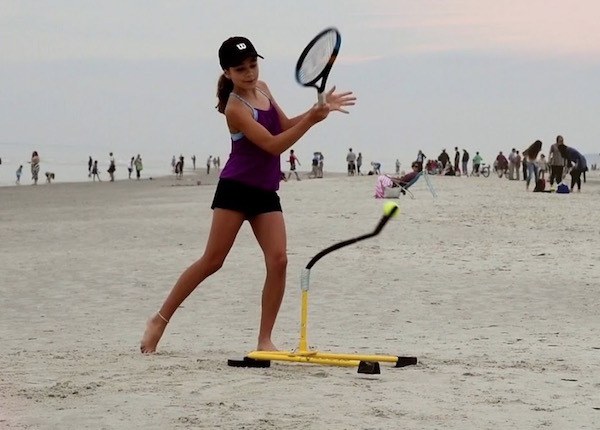
Stop paying full price for tennis gear! Get deals on shoes, racquets & more up to 70% off.
What are Tennis Training Aids?
Tennis training aids guide us to a different behavior on the court. That’s why I like to also call them guidance systems.
Training aids might help us with movement and footwork, technique and swing path, or tactics and strategy. They guide us to the correct behavior as determined by tennis coaches over the decades of our sport.
Here are a few examples of training aids or guidance systems that you may not have thought about.
- A visual guidance system is something we see that helps show us what to do. An example in tennis might be a large target to hit like the service box for a beginner, or our Numbered Cones below.
- A kinesthetic, or feeling, guidance system would be something we feel through touch. An example in tennis might be our Start Rite Grip Trainer below. When you put your hand on the racquet, you feel exactly what the grip should be and how it feels to swing with that grip.
Why Training Aids are Important in Tennis
There is a universal truth in tennis. Every player would like to play better!
The challenge is that all our tennis games plateau or get stuck at one point or another. It may be just your forehand or serve that’s stuck, or it could be your entire game. This playing level stagnation comes from a limitation in technique, physical, mental capacity, or all three.
Here’s what I found out after 40 years of research and clinical testing on literally thousands of tennis players. Each one of us learns most efficiently in one of the 3 predominant learning styles or a combination:
- Visual – seeing
- Kinesthetic – feeling
- Auditory – hearing
Interestingly, 98% of all tennis players learn best in an environment and with tools that tap into our visual and feeling learning style.
It is also interesting to note that tennis coaches and teaching pros teach about 90% of their lessons with words, an auditory learning style, which just doesn’t work well for teaching and coaching sports.
Training aids in tennis help players learn faster using kinesthetic (feeling) and visual (seeing) teaching methods.
Reviews of the 14 Best Tennis Training Aids
Let’s get started with the top 14 tennis training aids, or guidance systems, that will improve your tennis game faster than verbal instructions!
#1 – Topspin Pro: The #1 Way to Learn & Maximize Topspin (Editor’s Pick)
The Topspin Pro has quickly become one of the most popular tennis training aids in the world. It helps beginner tennis players learn topspin faster and advanced tennis players refine their technique.
How It Helps
The Topspin Pro forces you to use the proper swing path to generate topspin on your groundstrokes. It will help beginners feel the right way to swing to start using topspin on forehands and backhands. It helps higher-level players who want to add more spin to their groundstrokes as well.
How to Use the Topspin Pro
This training aid can be used on the court or at home. Many coaches use the Topspin Pro during private lessons or clinics for their students before they hit a tennis ball. From home, you can refine your technique by practicing with the Topspin Pro.
Other Features
You can remove the top screen to practice hitting a flatter ball. You can also use the Topspin Pro to work on your kick serve by holding it in your off-hand (video here).
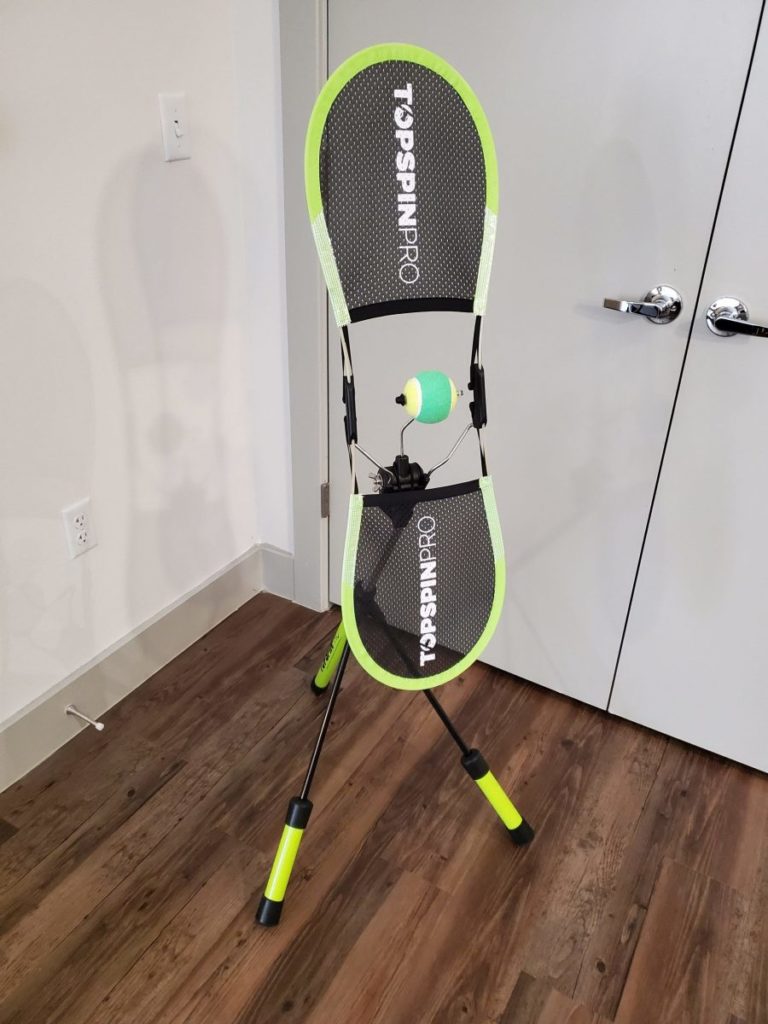
Read our Topspin Pro Review
#2 – Functional Tennis Saber: Better Contact on All Your Shots (Editor’s Pick)
The Saber is a tennis racquet with a smaller head size to help you improve your hand-eye coordination. You can play normal tennis points with this training aid and improve your contact point.
How It Helps
Because the Saber has a small head size, you must hit the ball in the middle of the strings for this to work. After playing with it for a while, the sweet spot on your normal racquet will feel massive and easier to find.
How to Use the Functional Tennis Saber
You can play normal tennis points with the Saber. Whether you’re trying to improve your forehand, backhand, volleys, or even serve, use the Saber for a bit before switching to your normal racquet. After mastering the shot with the Saber, it will become easier with your regular tennis racquet.
Other Features
Purchase two Sabers and play against an opponent. One set with the Saber and another with your regular racquets. See if it makes a difference.
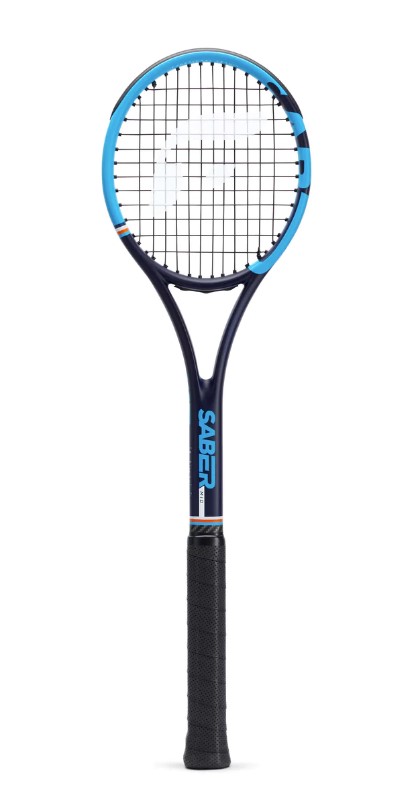
#3 – The Flex Trainer: Move Better on the Court
All over the world, tennis coaches tell their students “bend your knees!” Over and over and over again, the same instruction. The Flex Trainer helps force tennis players to listen to this advice.
How It Helps
The Flex Trainer is a training aid that helps people get used to swinging while bending their knees. It creates a great leg workout for players who want to get into great match playing shape.
How to Use the Flex Trainer
To put the Flex Trainer on, you wrap it around your waist with the adjustable velcro. Then you’ll do the same with the ankle braces.
After it’s comfortable, take some shadow swings or hit 5 to 10 shots. Then, remove it and hit another 5 to 10 tennis balls. You will quickly feel what it’s like to be in a more athletic stance. You can even use the Flex Trainer at home to practice your shadow swings, and moving around in a more athletic position.
You should wear socks or put them over warm-up pants for added comfort.
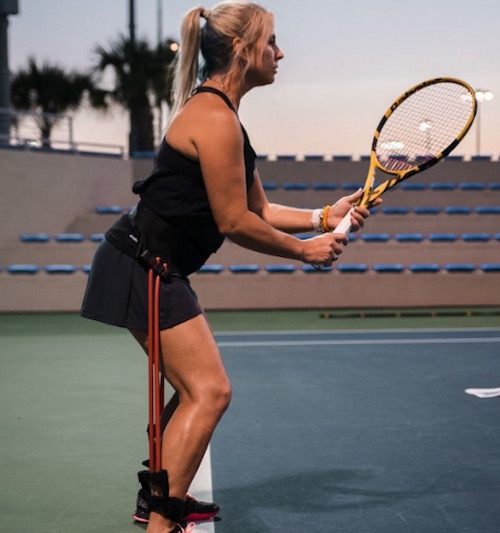
Other Features
The Flex Trainer comes with 6 resistance bands giving it three adjustable levels so it works for people of any height and leg power. You can also use the higher resistance bands to increase strength more rapidly.
#4 – Sweet Spot Trainer: Make Better Contact
How is it that the pros are able to hit the ball nearly perfectly every single time? The answer is thousands of hours of practice, and the Sweet Spot Trainer can help recreational players as well!
How It Helps
The Sweet Spot Trainer helps tennis players hit the ball in the center of the racquet. This is a great training aid for coaches and players at every level. It’s primarily used for on-court practice, but you can also use it hitting against the side of a building or a wall at home. If using it in your home, just use a foam ball.
How to Use the Sweet Spot Trainer
This device slides over the frame of your racquet and has velcro at the bottom to secure it in place. Then, use it to warm up, hit groundstrokes from the baseline, or volley for a few minutes to ensure you’re seeing the ball well. After you take the Sweet Spot Trainer off, you should be making improved contact with the tennis ball.
Other Features
The fabric creates a little more wind resistance, so it’s a great warm-up training aid to get your muscles loose.
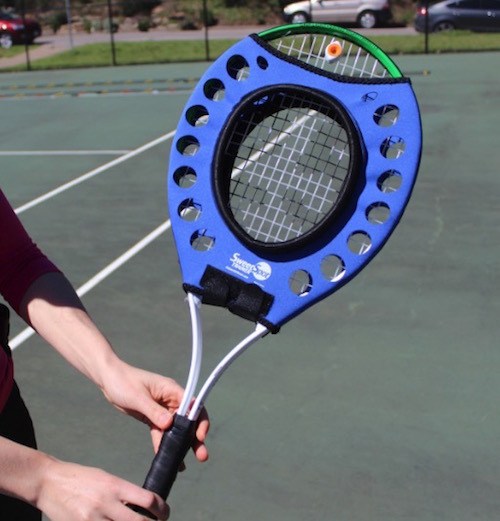
#5 – Start Rite Grip Trainer: Learn the Continental Grip
There is one almost universal skill that all good tennis players possess. It’s the continental grip. This fundamental tennis grip is the key to a consistent serve that is hit with spin, and it makes volleys much easier. Yet, so many beginners struggle to learn this important tennis grip.
How It Helps
The Start Rite Grip Trainer helps beginner tennis players learn the continental grip faster.
How to Use the Start Rite Grip Trainer
You simply wrap the training aid around the grip of the tennis racquet; the instructions show you where. The student should grip the racquet with the Grip Trainer between their pointer and index finger.
Other Features
You can also slide the trainer down to the end of the racquet to help players whose grip slips at the heel of their hand or use both that come in the kit, one at the top and one at the bottom.
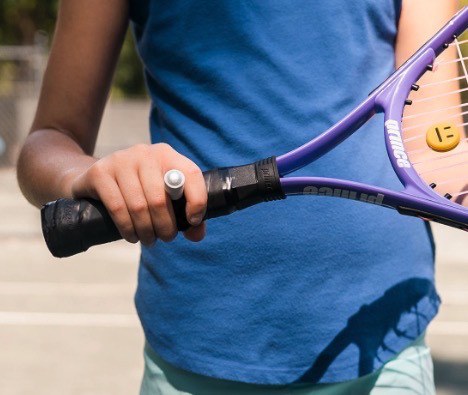
#6 – Serve Rite Racquet: Serve Training Aid for Juniors
The serve is the one stroke most kids struggle to learn when they begin playing tennis. This serve training aid changes that.
How It Helps
The Serve Rite Racquet is a junior racquet that helps young children to serve the right way, with the right grip.
How to Use the Serve Rite Racquet
When it’s time to practice serves, have the kids use this racquet. The grip is built to ensure the child uses a continental grip, so they naturally build the fundamentals of good serve technique. Another exercise is to use the racquet and bounce the ball up without letting it touch the ground while creating underspin. This will help anyone start to get a feel for the continental grip for volleys, serves, dropshots, etc., in minutes.
Other Features
The racquet is 23 inches long and made for juniors only, although adults with small hands can also benefit. There is only a right-handed model available at this time.
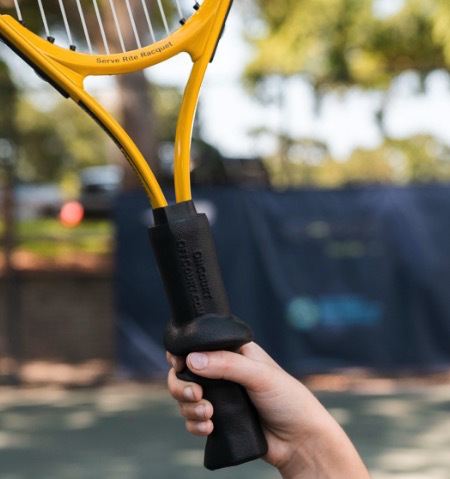
#7 – Backswing Solution: Improve Your Volleys and Return of Serve
The return is one of the most important shots in tennis. With many recreational players playing doubles today, solid volleys are also an essential skill. The most common mistake players make on both of these shots is taking the racquet too far back.
How It Helps
This training aid helps players use a short backswing on their volleys and returns. The goal of each shot is to block the ball back with a short backswing. It’s a great tool to practice half-volleys as well.
How to Use the Backswing Solution
Strap it over the player’s shoulders with the bar in front, and feed them volleys. Have them focus on footwork and body control while blocking the ball back. The training aid helps them keep their racquet out in front with a short backswing.
Flip the bar to the back and work on returns. They won’t be able to use a long backswing so they will have to use the pace of the ball coming at them.
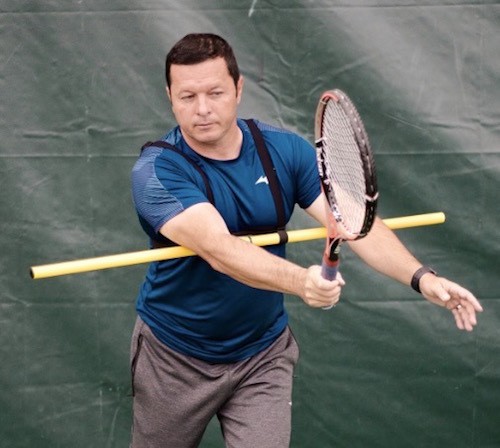
Other Features
The straps are adjustable so this training aid will work for both bigger adults and small adults or junior players.
#8 – Donuts: Improve Your Footwork
Footwork is something that tennis coaches stress to players all around the world. Without getting your feet into the right position, it will be nearly impossible to execute the shot.
How It Helps
The Quick Feet & Big Feet Donuts are training aids that work as a guidance system for a player’s footwork. They can help with a player’s split-step and other common footwork patterns in tennis.
How to Use Tennis Donuts
All you have to do is place the Donuts on the court or surface where the players should be moving their feet. In clinics or lessons, the player will use the Donuts as a movement guide to step inside during drills. Many coaches use the Donuts for split stepping or a recovery target between shots. They can also be used as targets for serving or other drills.
Other Features
These Donuts have anti-slip technology built in. They stay down in windy conditions and resist dirt well.
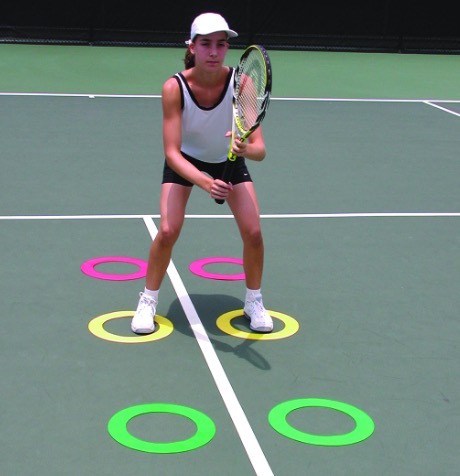
#9 – Numbered Cones: To Train Quick Decision-Making
There are some basic high-percentage guidelines when deciding where to hit the tennis ball during a point. From the baseline, hit most incoming crosscourt balls back crosscourt. Another guideline is you should rarely change the direction of a hard-hit ball.
How It Helps
Numbered Cones create targets for you to aim towards during tennis lessons, drills, or when practicing with a tennis ball machine. You can practice hitting with different directions and placements, along with making targeting adjustments with this training aid.
How to Use Numbered Cones
Simply place the Numbered Cones on the other side of the net in areas that you want to target. Some tennis coaches will call a number out while the incoming ball is in the air. This helps a player make quick decisions during a point.
Other Features
The cones are numbered and color-coordinated. They are 9 inches tall and very durable. You can create all sorts of one-on-one games with this training aid.
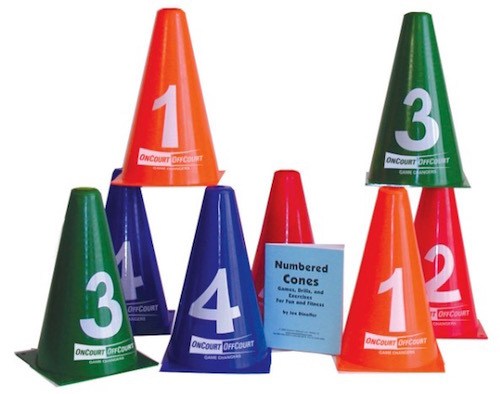
#10 – Topspin Solution: Hit with More Spin
Hitting the tennis ball with spin is arguably one of the most important skills a player should learn. Topspin, backspin, and sidespin are all great weapons to have on the court. Top players employ spin on nearly every shot. Topspin, specifically, helps you control the ball, and push the opponent back into the court.
How It Helps
The Topspin Solution helps beginners and intermediate players learn to feel the right swing path for hitting with topspin.
How to Use the Topspin Solution
You can hang the training aid on a fence, basket, or even a chair with a narrow back. After it is in place, practice swinging with your racquet and making the ball spin. Brush the ball to feel the tennis strings create spin on the ball. You can practice at the courts or from home with the Topspin Solution.
Other Features
You can adjust the height and position of the ball to practice topspin or backspin. You can even turn the ball sideways to practice your slice serves.
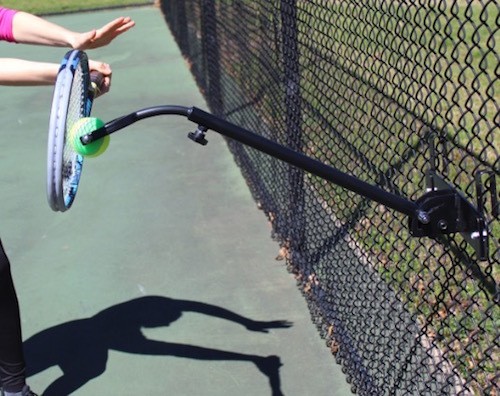
#11 – Billie Jean King’s Eye Coach: Hit The Sweet Spot Consistently
Tennis is a rhythm sport that also requires tremendous visual focus. That’s why so many tennis players hear their coaches say “watch the ball hit the strings.” The truth is you cannot watch the ball actually hit the strings. That moment is too fast for the eye to see. However, you can train your eyes to view the final 3 feet before contact.
How It Helps
The Eye Coach helps train players to see the ball resulting in better contact. Ultimately, it helps you hit the sweet spot of the racquet more consistently.
How to Use the Eye Coach
Set up the Eye Coach on the court or in your home. You can practice repetition of your groundstrokes or volleys to improve your hand-eye coordination and timing.
Other Features
The Eye Coach comes in two sizes: for juniors or adults. You can adjust the height of the training aid as well. The Junior size stands at 28.5 to 30.5 inches tall, while the adult version can be adjusted from 32 to 39 inches tall.
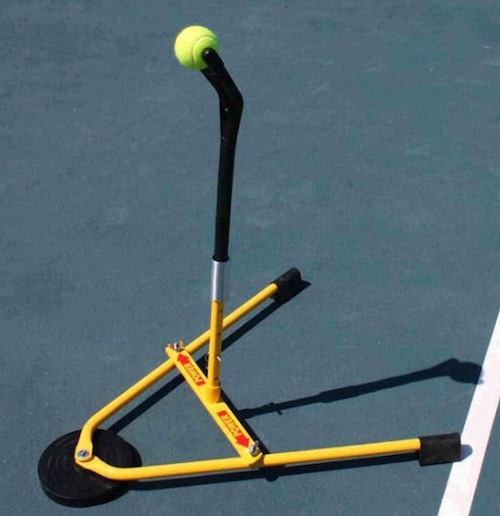
#12 – Serving Sock: Improve Your Serve’s Power & Spin
The serve is the most important shot in tennis. Around 40% of all swings at the ball during a singles match is the serve motion. Relaxation is one of the keys to a better serve since the more fluid the service motion, the greater the racquet speed, resulting in more spin and power.
How It Helps
The Serving Sock helps train your service motion to be continuous, fluid, and relaxed. If you have any hitches in your serve motion, this training aid will find them. After using this tool, you will generate more spin and power on your serve.
How to Use the Serving Sock
Hold the end of the Serving Sock and make a service motion. You should be able to go through your full motion without the ball hitting you. If the ball hits you in the back, then you should adjust your motion. For a little challenge, you can also try tossing a ball and hitting it with the ball at the end of the sock.
Other Features
The Serving Sock comes with a real tennis grip, so it feels like you’re holding a racquet. The distance from the grip to the end of the device is the same length as the distance from the grip to the sweet spot on an adult tennis racquet. You can use it in your home, garage, backyard, or on the court.
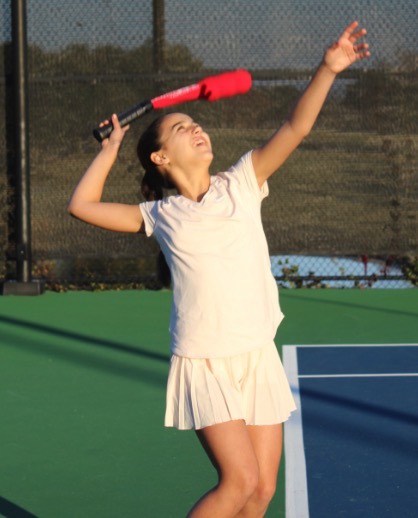
#13 – Angle Doctor: Don’t Chop Down on Volleys
One of the biggest challenges faced by players of all levels is chopping down on volleys and therefore hitting too many volleys into the net. This pattern of mistakes has frustrated recreational tennis players for decades.
How It Helps
The Angle Doctor from OnCourt OffCourt helps tennis players use the right racquet position on volleys and slice backhands. Players who chop down on volleys will start hitting through the ball better with this training aid.
How to Use the Angle Doctor
The Angle Doctor has wraps around your arm on one end, and has an adjustable velcro strap that you’ll attach to your racquet on the other. Adjust the strap until you have the right angle of the racquet with proper space and extension between the racquet and the arm. Hit a few minutes of volleys or slice backhands this way. Then, take it off to practice without it, trying to repeat the same guided swing path.
Other Features
You can also extend the velcro strap to work on topspin groundstrokes. You can practice on the court or at home against a wall.
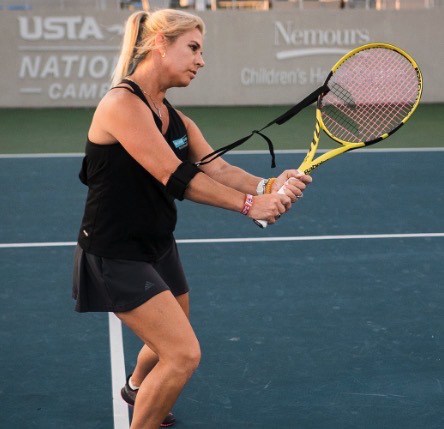
#14 – Scorbly Tennis Score Keeper: Learn to Keep Score (and more!)
Tennis keeps score in a very weird way, and it can be difficult to learn how it works. This is an electronic scoreboard that can easily be brought with you to the court to help you keep score.
Not only that, it can help even veteran players by keeping score for you, so you never have to pause play again because of a score dispute. Plus, it works great if you have parents, coaches, or any other spectators watching, helping them keep up with the game score. Note: When I first unpacked it, I thought the remote would be annoying or get in the way, but it absolutely didn’t. It took no time at all to adjust to having (and using) the remote and everybody I played with loved the scoreboard!
How It Helps
The Scorbly Tennis Score Keeper is a portable scoreboard that attaches to fences and nets with ease. It clearly displays the score for players, coaches, and spectators.
How to Use the Scorbly Tennis Score Keeper
The Scorbly Tennis Score Keeper comes with a remote that attaches to your shorts or skirt. It has 4 buttons to increase the score for either team, reverse the score in case of mistake, and send the score forward again after mistakenly reversing it. The 4th button also tells you who is supposed to be serving if the score is not currently reversed at all, which can especially come in handy in tiebreaks. You can also change to several different formats, such as ad or no-ad scoring, a super-tiebreak in lieu of a full 3rd set, and more.
Other Features
While the main intention of this device is to keep score so you don’t have to, it can also be used to learn how to keep score, track the proper server (even in doubles), or just help spectators/coaches track the score easier than a standard scoreboard.

Stop paying full price for tennis gear! Get deals on shoes, racquets & more up to 70% off.
How to Find the Right Tennis Training Aid for You
Whether you’re a coach or a player, tennis training aids can help improve your game faster. The best way to find the right training aid is to first choose a skill or problem you want to correct.
If you want to improve your topspin, for example, the Topspin Solution above is a great tool. If you need to work on point play patterns, then the Numbered Cones might be best for you.
Each training aid above is designed and proven to help improve specific skills in your game. So, you should ask yourself, “what skills do I need to improve to take my tennis game to the next level?”
Then choose a tennis training aid above and practice!
This guest post was written in collaboration with Joe Dinoffer.
Joe is a Master Professional in both the USPTA and PTR, a distinction awarded to only a handful in the tennis industry, and has won numerous regional and national awards of distinction. He is the author and editor of nine books and more than 20 DVDs, as well as 500 video clips on YouTube. Joe has been a frequent speaker at national and international tennis conferences, having presented at over 300 different conventions in his career. He is the founder and president of OnCourt OffCourt.

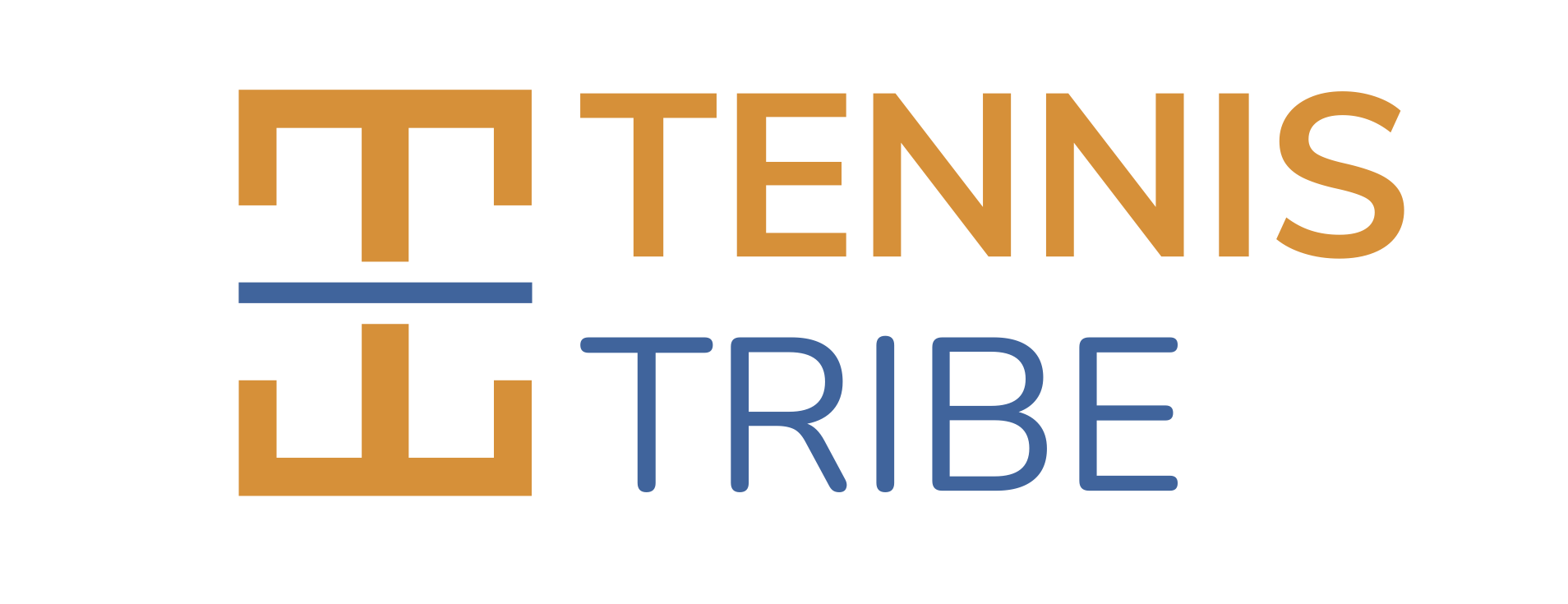
Leave a Reply